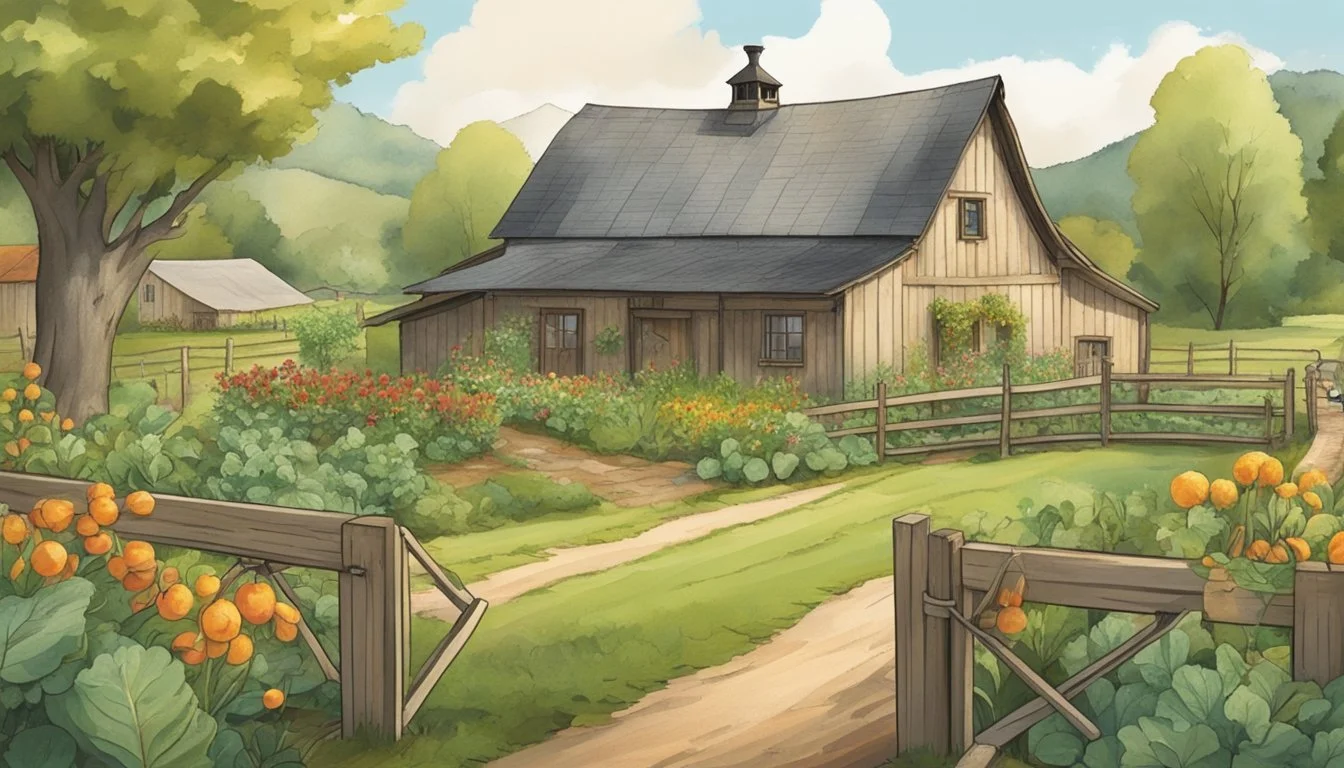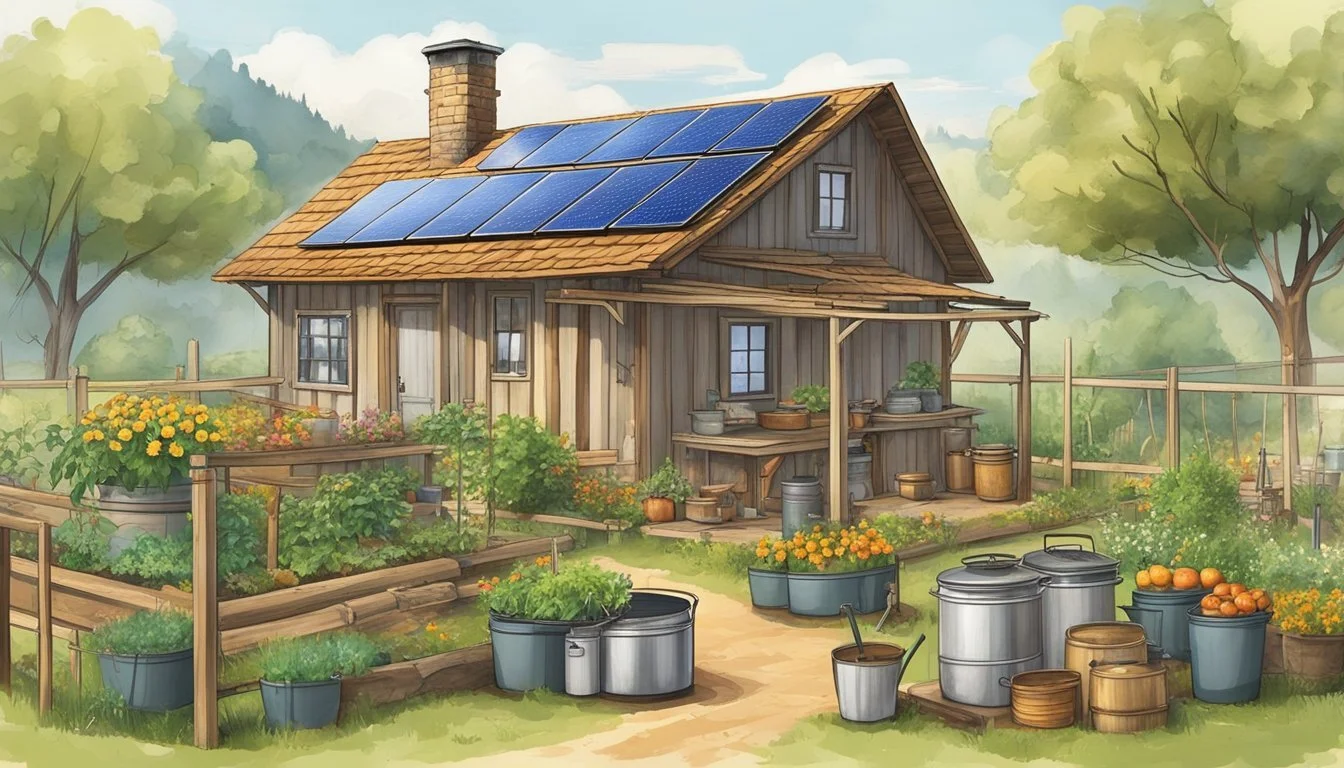The Use of Traditional Knowledge in Modern Homesteading
Bridging Past and Present Practices
Homesteading has evolved from a historical necessity into a lifestyle choice, intertwining traditional knowledge with modern innovations to create a blend of sustainable living practices. This fusion of old and new allows individuals to live off the land more efficiently, utilizing the skills handed down by ancestors while embracing the advancements of the present. Through a modern homestead, they seek to minimize their ecological footprint by revamping the traditional homestead principles of self-sufficiency and community resilience.
The tapestry of homesteading is rich with the threads of history and progress. Traditional skills such as gardening, animal husbandry, and food preservation are not relics of the past but are priceless assets in the modern homesteaders' toolkit. These practices, once critical for survival, are now adopted and adapted to meet the challenges of contemporary sustainability. As they navigate the complexities of living in an interconnected world, modern homesteaders integrate these time-honored techniques with current knowledge and technology to thrive within their environment.
Importantly, this resurgence of living off the land is marked by a consciousness of sustainability that respects both history and progress. The modern homesteading movement cherishes the wisdom of generations past while employing innovative methods to aid in effective land management and resource conservation. By studying the intricacies of traditional homesteads and applying them in today's context, modern homesteaders are crafting a lifestyle that honors the Earth's limited resources and their own independence within it.
History and Evolution of Homesteading
Homesteading has a rich tapestry of origins and practices that have evolved from legislative acts to current sustainable living strategies. The transformation from historical policies to today's movement embodies generations of knowledge and adaptation.
From the Homestead Act to Modern Times
The Homestead Act of 1862 played a pivotal role in shaping the American frontier. It allowed individuals to claim up to 160 acres of public land, requiring claimants to cultivate and improve upon it to gain ownership. This legislation catalyzed the settlement of millions of acres and is regarded as instrumental in advancing westward expansion.
Modern homesteading, however, diverges from its 19th-century counterpart by emphasizing sustainability and reducing dependence on societal infrastructure. It retains the core essence of being self-sufficient but integrates contemporary advances in technology, allowing practitioners to live more comfortably and efficiently.
Influence of Ancestors on Contemporary Practices
Traditional homesteading, ingrained with wisdom from ancestors, has profoundly affected today’s practices. Rooted in history, it consisted of skills and knowledge essential for survival, such as food preservation, animal husbandry, and organic farming. It is established that ancestral methods substantially inform modern techniques, allowing for a hybrid of time-tested practices with new innovations.
Contemporary homesteaders often look to history for inspiration, striving to master traditional homesteading skills which are making a resurgence. By adopting and enhancing these ancestral methods, today’s homesteaders aim to live in harmony with the environment, promote self-reliance, and foster a strong sense of community reminiscent of early traditional homesteads.
Fundamentals of Modern Homesteading
Modern homesteading merges traditional practices with contemporary advances, focusing on sustainability and self-reliance. It is guided by a distinctive lifestyle and mindset aimed at achieving a more simple life.
Defining the Homesteading Lifestyle
The modern homestead is a place where traditional skills are utilized alongside technological advancements to create a sustainable, self-sufficient environment. Efforts are often centered around growing one's own food, harnessing renewable energy, and reducing waste. Those embracing the homesteading lifestyle seek to reconnect with the land, fostering a cycle of consumption and replenishment that respects natural resources.
Adopting a Homesteading Mindset
Embarking on a homesteading journey requires a specific mindset that embraces challenge, fosters adaptability, and prioritizes learning. This mindset champions a simple life, valuing experiences over possessions and highlighting the benefits of minimalism. Sustainability is at the core of this philosophy, dictating daily choices and long-term goals to minimize environmental impact while maximizing self-reliance.
Homesteaders are advancing a crucial dialogue about responsible living practices by melding reverence for past knowledge with eco-conscious innovation.
Incorporating Traditional Knowledge
In the realm of modern homesteading, the integration of traditional knowledge is crucial for the preservation of skills and the seamless fusion of historical practices into contemporary living.
Preservation of Skills and Crafts
Traditional skills such as woodworking, blacksmithing, and weaving are vital to the fabric of homesteading. Individuals preserve these skills not only as hobbies but as a means of self-sufficiency. In regions like Appalachia, the Foxfire books have played a pivotal role in documenting these valuable crafts. The preservation of these skills enables homesteaders to maintain and repair their tools and homes with the simplicity and effectiveness characteristic of the old ways.
The Role of Traditional Skills in a Modern Context
Incorporating traditional skills into modern homesteading goes beyond preserving the past; it equips homesteaders with practical abilities that can sometimes outperform modern alternatives. For example, understanding the basics of organic gardening can lead to healthier soil and food that is free from synthetic inputs. This not only reflects a sustainable approach but also harks back to times when homesteaders had no option but to rely on natural resources.
Learning from Historical Homesteading Practices
Studying historical homesteading practices provides invaluable insights into working harmoniously with nature. Efficiency in old homesteads was not solely about technology; it was about understanding the rhythms of the land and leveraging them to one's benefit. For instance, water-management techniques, such as rainwater harvesting methods, are ancient practices that modern homesteaders adapt for irrigation and household use, considering environmental and resource sustainability.
Sustainable Living and Self-Sufficiency
Sustainable living combines traditional knowledge with new technologies to achieve self-sufficiency, meeting one's needs from the surrounding environment. This notion includes growing organic food, raising livestock, and utilizing renewable energy sources.
Embracing a Self-Sufficient Lifestyle
Adopting a self-sufficient lifestyle means minimizing dependence on external resources by maximizing the use of one's land and resources. Households strive to become self-reliant through various means such as permaculture, a system of agricultural and social design principles centered around simulating the patterns and features observed in natural ecosystems.
Gardening and Food Production
A cornerstone of self-sufficiency is the ability to produce one's own food. Individuals often start by developing a garden, which can range from small container gardens to extensive vegetable plots. Organic food production is prioritized, with individuals often using heirloom seeds and implementing natural pest control methods.
Vegetable Gardening: Cultivating a variety of crops suitable for the local climate.
Livestock Management: Rearing chickens, goats, or bees to complement the garden produce.
Energy Solutions and Off-Grid Living
Those pursuing sustainable living frequently explore energy solutions to reduce their carbon footprint. Solar panels are a popular choice, as they provide a clean, renewable source of electricity, allowing for off-grid living. Gravity-fed water systems and bio-gas installations are other facets of this energy-independent lifestyle.
Renewable Energy Sources:
Solar: Utilizing photovoltaic cells for electricity.
Wind: Harnessing wind power through turbines.
Hydro: Small-scale hydroelectric generators in suitable locations.
By integrating traditional methods with modern technology, individuals can lead a lifestyle that is both sustainable and self-sufficient, reducing their environmental impact while maintaining a connection with nature.
Practical Homesteading Skills
In modern homesteading, combining traditional techniques with contemporary knowledge is key to self-sufficiency. The skills involved are diverse, ranging from animal husbandry to land cultivation and food preservation. Each plays a vital role in creating a sustainable and productive homestead.
Animal Husbandry and Livestock Care
They must understand the nuances of animal husbandry and livestock care to keep their animals healthy and productive. This includes regular feeding schedules, vaccination programs, and proper sheltering. For example, caring for chickens involves tasks such as maintaining clean coops, providing a balanced diet, and protecting them from predators.
Feeding: Ensuring a balanced diet for different types of livestock.
Health: Regular health checks and vaccinations.
Shelter: Adequate protection against elements and predators.
Cultivating the Land
Homesteaders must become adept at cultivating the land to produce a diverse array of crops. They should understand soil health, crop rotation, and sustainable gardening practices. Whether one is planting a vegetable garden or an orchard, gardening skills are essential for yielding abundant harvests each season.
Soil Health: Testing and amending soil to ensure optimal growing conditions.
Crop Rotation: Planting different crops in succession to maintain soil fertility.
Sustainable Practices: Utilizing methods like composting and mulching to enrich the land.
Home Preservation Techniques
To ensure food security throughout the year, homesteaders employ various home preservation techniques. Techniques such as canning, making jams and jellies, and fermentation are integral to prolonging the shelf life of the harvest. Properly preserved, these foods can provide nourishment even in the off-season.
Canning: Utilizing heat to seal food in airtight containers.
Jam and Jelly Making: Cooking fruits with sugar to create spreads that last for months.
Fermentation: Encouraging the growth of beneficial bacteria to preserve and enhance foods.
Modern Techniques and Traditional Practices
The melding of modern conveniences with traditional homesteading methods opens a realm where technology and the old ways coexist. This synergy enhances the efficiency and sustainability of a modern homesteader's lifestyle while preserving the essence of self-reliance.
Integrating Technology with Homesteading
Modern homesteading often incorporates innovative technology to streamline processes and boost productivity. For instance, solar panels and rainwater harvesting systems enable homesteaders to generate their own energy and water supply, lessening their ecological footprint and fostering progress in sustainable living.
Renewable Energy: Solar, wind, and hydro power systems
Water Systems: Smart irrigation and rainwater collection
Automated Solutions: Programmable thermostats and coop doors
Old Ways in the New Age
Despite the allure of technology, successful modern homesteaders recognize the value in upholding time-honored practices. Seed saving, natural pest control, and composting are just a few examples of how they maintain ecological harmony and self-sufficiency, honoring the wisdom of their predecessors while navigating today's challenges.
Seed Saving: Ensuring crop diversity and resilience
Pest Control: Utilizing beneficial insects and companion plants
Composting: Turning waste into nutrient-rich soil amendments
Building and Nurturing Community
In the realm of modern homesteading, the strength of a community can be a critical factor in the success and growth of individual homesteads. By sharing resources, knowledge, and labor, homesteaders create a synergy that enriches everyone involved.
The Role of Community in a Homestead
Community serves as a foundational element for modern homesteaders, specifically in urban environments where space and resources can be limited. In the city, where individual efforts may face constraints, collective action becomes imperative. Forming community alliances allows for shared garden spaces, tool libraries, and the combined purchasing power for materials, which can lead to cost savings and reduced waste.
Homesteading skills are often cultivated through experience and tradition, carrying a practical value that is amplified when shared. For instance, communities may organize workshops where novices can learn from seasoned practitioners. Topics can range from organic gardening to renewable energy installation. These communal learning environments not only expand personal capabilities but also foster a sense of unity and trust among participants.
Sharing Knowledge and Skills
Skill-sharing is a cornerstone of the homesteading community, enabling individuals to learn from one another and to become more self-sufficient. Established homesteaders might offer workshops or informal gatherings to teach skills such as:
Preservation Techniques: Canning, drying, and fermenting to extend the harvest.
Craftsmanship: Woodworking or metalworking for building and repairs.
These gatherings are not just instructional; they act as social glue, bonding members of the community together. By sharing knowledge in areas such as sustainable agriculture or energy solutions, homesteaders collectively enhance their ability to live off the land responsibly and creatively. Skills passed on through hands-on workshops have the power to transform novices into knowledgeable stewards of their environment.
Land and Location Considerations
The success of a homesteading endeavor is greatly influenced by the choice of land and location. Prospective homesteaders must consider the attributes of their potential rural life and the nature of the land itself, ensuring compatibility with their goals.
Choosing the Right Homestead Location
One's choice of location is pivotal. Key factors include climate, soil quality, water access, and community resources. Enthusiasts should read a map and research local zoning regulations to determine the viability of their planned activities. Utilizing tools such as a compass alongside maps can aid in understanding the geographic orientation and potential of the land.
Climate: Influences the types of crops that can be grown and the necessary structures for animals.
Soil Quality: Determines the fertility and what amendments, if any, are needed.
Water Access: Is crucial for irrigation, livestock, and personal use.
Community: Proximity to like-minded individuals can provide support and shared knowledge.
Understanding and Working with Nature
Working harmoniously with nature contributes to a sustainable homestead. Prospective homesteaders should observe natural patterns, such as water flow and sun exposure. Knowledge of local flora and fauna and natural resource management is also integral.
Topography: Influences water drainage and wind patterns.
Sun Exposure: Affects the planning and placement of crops and buildings.
Natural Resources: Availability of wood for heating or construction, natural bodies of water, and fertile land.
Understanding these considerations—while staying attuned to the rhythms and cycles of nature—is critical for carving out a slice of rural life that is as rewarding as it is sustainable.
Health and Wellness from the Homestead
In the realm of modern homesteading, health and wellness emerge not just as byproducts, but as intentional results of practices like consuming natural and organic food and understanding the impact of fermentation on gut health.
Natural and Organic Food
Modern homesteaders are turning back to traditional knowledge to enhance their well-being. They often grow their own food using organic gardening methods, free from synthetic pesticides and fertilizers. This leads to a bounty of fruits and vegetables that not only taste better but are also rich in nutrients. Studies suggest that organic produce may have higher levels of certain antioxidants and micronutrients such as vitamin C, zinc, and iron.
Fermentation and Gut Health
Another cornerstone of health on the homestead is the art of fermentation. This age-old preservation method is known to boost gut health by increasing the presence of probiotics in foods. Homesteaders often ferment their own vegetables, dairy, and grains, resulting in products like sauerkraut, kefir, and sourdough bread. These fermented foods provide beneficial bacteria that support a healthy digestive system and, by extension, a robust immune response.
Homesteading Hobbies and Leisure
In the realm of modern homesteading, hobbies not only become a source of joy but also a means to acquire vital survival skills. Through activities such as cooking from scratch and crafting homemade items, individuals can enjoy leisure time while also preparing for self-sufficiency.
The Joy of Homestead Crafting
Homesteading offers countless opportunities for crafting, where traditional techniques merge with leisurely pursuits. For example, the art of fermentation is both a pastime and a practical method for preserving food. Enthusiasts might spend hours preparing sauerkraut or kombucha, relishing the fact that they are creating healthful goods in the comfort of their home.
Another popular activity is the creation of homemade soap, which combines the science of chemistry with the satisfaction of producing a useful and personalized product. Similarly, operating a sewing machine transforms material into garments and home textiles, turning a hobby into a custom and cost-effective wardrobe solution.
Homesteading as a Survival Skill
For many, homesteading transcends hobby status and becomes integral to developing survival skills. In the kitchen, cooking from scratch is a foundational practice, ensuring that individuals can nourish themselves regardless of external circumstances. Those who master this skill appreciate the control over ingredients and the joy of creating meals from the ground up.
Outside of the kitchen, making homemade candles equips homesteaders with a source of light and warmth, essential in situations where modern utilities might fail. This form of crafting represents the ingenuity and resourcefulness embedded in the homesteading ethos. It showcases how leisure activities are also preparations for self-sufficiency and unpredictability.
Environmental Stewardship and Responsibility
Modern homesteading encapsulates the essence of environmental stewardship by prioritizing sustainable practices that minimize waste and pollution. These efforts foster a responsible relationship with the environment, crucial for the longevity of both natural ecosystems and human well-being.
Composting and Waste Reduction
Composting serves as a pivotal strategy within homesteading to reduce waste and replenish soil health. By transforming organic waste into nutrient-rich compost, homesteaders effectively divert materials from landfills where they would contribute to methane emissions, a potent greenhouse gas. This practice exemplifies environmental stewardship, turning everyday waste into valuable resources that sustain the cycle of growth.
Steps to Effective Composting:
Collect organic waste, including food scraps and yard trimmings.
Layer your compost pile, alternating between greens, like vegetable waste, and browns, such as dry leaves.
Maintain the pile by turning it regularly to aerate and speed up the decomposition process.
Harvest the compost once it is dark, crumbly, and earthy-smelling, indicating maturity.
Through these actions, the reduction of waste directly impacts and mitigates air pollution, as less organic material is left to decompose anaerobically in landfills.
Reducing Dependency on Plastic and Chemicals
Homesteaders reduce their environmental impact by lessening their dependency on plastic and synthetic chemicals. They understand the significance of sustainability and actively seek alternatives to these pollutants, which are known contributors to environmental degradation.
Alternatives to Plastics and Chemicals:
Use glass or stainless steel containers instead of plastic.
Opt for natural cleaning agents like vinegar, baking soda, and lemon.
Grow a garden to limit the purchase of store-bought goods that often come in plastic packaging.
Make homemade personal care products to avoid the chemicals and plastics in commercial items.
Each initiative plays a role in combating plastic pollution, a critical aspect of environmental stewardship. It not only calls for individual action but also inspires community-wide responsibility for protecting air quality and overall ecosystem health.
Conclusion
Incorporating traditional knowledge into a modern homestead is not only an act of preserving history but also a means to enhance sustainability and environmental stewardship. A revival of time-honored skills brings with it a wealth of benefits, including increased self-reliance and a reduced ecological footprint. The overarching theme is clear: blending the wisdom of the past with the innovations of the present fosters a resilient and ethical way of living.
Homesteading today thrives on the fusion of historic practices and contemporary techniques.
Sustainability is the core outcome, aimed at creating a balance with nature while ensuring personal autonomy.
The transfer of knowledge across generations is pivotal to the enrichment of homesteading culture.
Cultivating skills rooted in tradition is critical for a harmonious relationship with the land.
Environmental stewardship is underscored through these practices, highlighting a commitment to protecting the land that sustains homesteaders.
Modern homesteaders are proving that traditional methods have a valuable place in the context of today's environmental and social challenges. They demonstrate that living off the land is not only possible but also practical and rewarding. These individuals embody a lifestyle that respects the finite resources of our planet while nurturing a connection to the earth that is often lost in the urban milieu. This return to the roots, so to speak, promises a sustainable path forward for both current and future generations seeking a more deliberate and grounded way of life.










